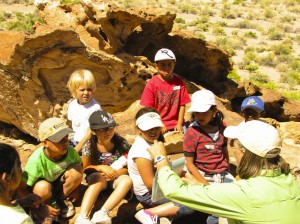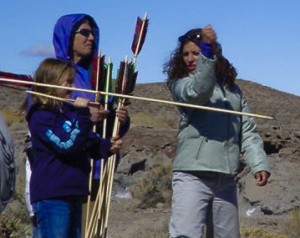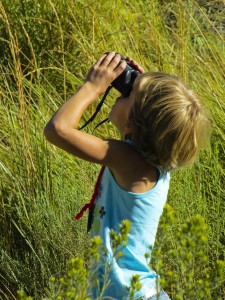In 2004 ESWP collaborated with the Bureau of Land Management’s Hands on the Land program, beginning the expansion of the watershed project into the elementary classrooms. Through directed scientific investigations, 2nd and 4th-grade students have the opportunity to explore Fish Slough, a wetland located in the arid Owens Valley.
SECOND GRADE – This field trip starts with a puppet show introducing the students to some of the animals that live in Fish Slough. After which the students will go on a Discovery hike and have a chance to explore life in the slough. Classroom activities included the National Geographic Geo Kids video Tadpoles, Dragonflies, and the Caterpillar’s Big Change and a classroom follow-up activity Are You My Baby?
- Fish Slough Water Critters – This station introduces students to the aquatic macroinvertebrates living in a slow-moving warm water system. Students collect the macroinvertebrates using small dip nets, after which they sort and identify their invertebrates using a large mat that has illustrations of the most common invertebrates living in Fish Slough.
 Fish Slough Discovery Hike – The discovery hike is designed to touch on a few of the 2nd grade Science and Social Studies content standards in a fun and engaging way. The students follow clues though through upland habitat which engage them in activities from identifying animal tracks and scat to finding evidence of the volcano that erupted millions of years ago creating the unique rock formations they are hiking over.
Fish Slough Discovery Hike – The discovery hike is designed to touch on a few of the 2nd grade Science and Social Studies content standards in a fun and engaging way. The students follow clues though through upland habitat which engage them in activities from identifying animal tracks and scat to finding evidence of the volcano that erupted millions of years ago creating the unique rock formations they are hiking over.
FOURTH GRADE – The fourth-grade students are introduced to the unique aspects of the Fish Slough desert spring ecosystem through four activities.
 Plant Communities – This station introduces students to ecosystems and plant communities. Students look at three plant communities, desert scrub, alkali scrub, and alkali meadow, and explore how plants adapt to the different demands of each place.
Plant Communities – This station introduces students to ecosystems and plant communities. Students look at three plant communities, desert scrub, alkali scrub, and alkali meadow, and explore how plants adapt to the different demands of each place.- Archeology – Students are introduced introduces to the science of archaeology by exploring an early man site. Students will learn how artifacts left behind provide a key to how people lived at Fish Slough long ago.
- Geology of Fish Slough -Here students examine how the forces of nature, faulting, volcanism, glaciations, and erosion have shaped Fish Slough and the Owens Valley.
- Owens Pupfish – In this activity the students participate in a scientific investigation, “The Mystery of the Missing Pupfish.” Students collect data on plant and animal life in and around the slough, water conditions before they create their own hypothesis on why the endangered Owens pupfish is no longer present at this location.
Classroom activities include the use of two Great Explorations in Math and Science (GEMS) Lawrence Hall of Science, Berkeley guides, Stories and Stones, and Exploring Artifacts, plus materials on the Owens Valley Paiute, the geology of the Owens Valley, desert plants, and directions for making petroglyphs and twined baskets.
For more information on the 2nd and 4th grade Eastern Sierra Watershed Project/BLM Hands-on-the-Land trips, or to volunteer, please contact project coordinator, Nicole Elgersma, at nelgersma@inyocoe.org, or 760-873-3262, ext. 2131
More details about current programs on Inyo County Office of Education’s ESWP Google Site here.
THIRD GRADE – Exploring a Wetland – The third-grade program is designed in cooperation with the Bishop Paiute Tribe Environmental Office, Eastern Sierra Audubon, U.S. Forest Service, and the Bureau of Land Management. The students go to the Bishop Paiute Tribe’s Conservation Open Space Area (COSA) and participate in 4 activities.

- Birding – Students are taught how to use binoculars and then go on a bird walk to identify the many different birds living on the COSA.
- Native Fish – Students play a game to learn what fish are native or introduced. They then participate in a fish trapping survey to learn what kind of fish live in the pond. All fish are identified and measured.
- GIS/ Herbarium – The students tour the Forest Service and BLM herbarium and then see how GIS maps can show you lots of information about your neighborhood.
- Native plants and their uses – Students learn about native plants and how the Paiutes use some of the plants, such as baskets made from willow and mats made from tules. Finally, they share a cup of tea made from local mint leaves.
The 3rd Grade “Exploring a Wetland” program has grown into monthly walking field trips for 3rd grade students throughout the county in a program called “Taking Root.”
For more information on the 3rd-grade Taking Root program or to volunteer, please contact project coordinator, Nicole Elgersma, at nelgersma@inyocoe.org, or 760-873-3262, ext. 2131
More details about the Taking Root program on Inyo County Office of Education’s Taking Root Google Site here.

